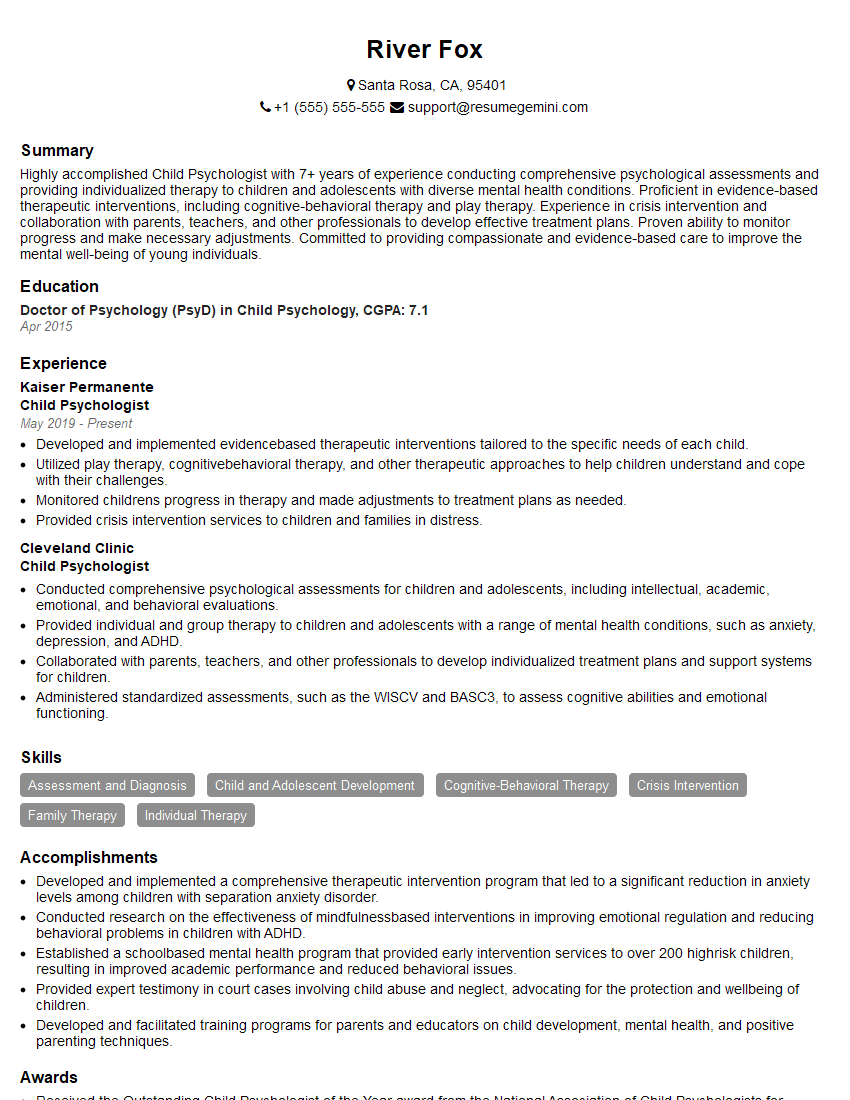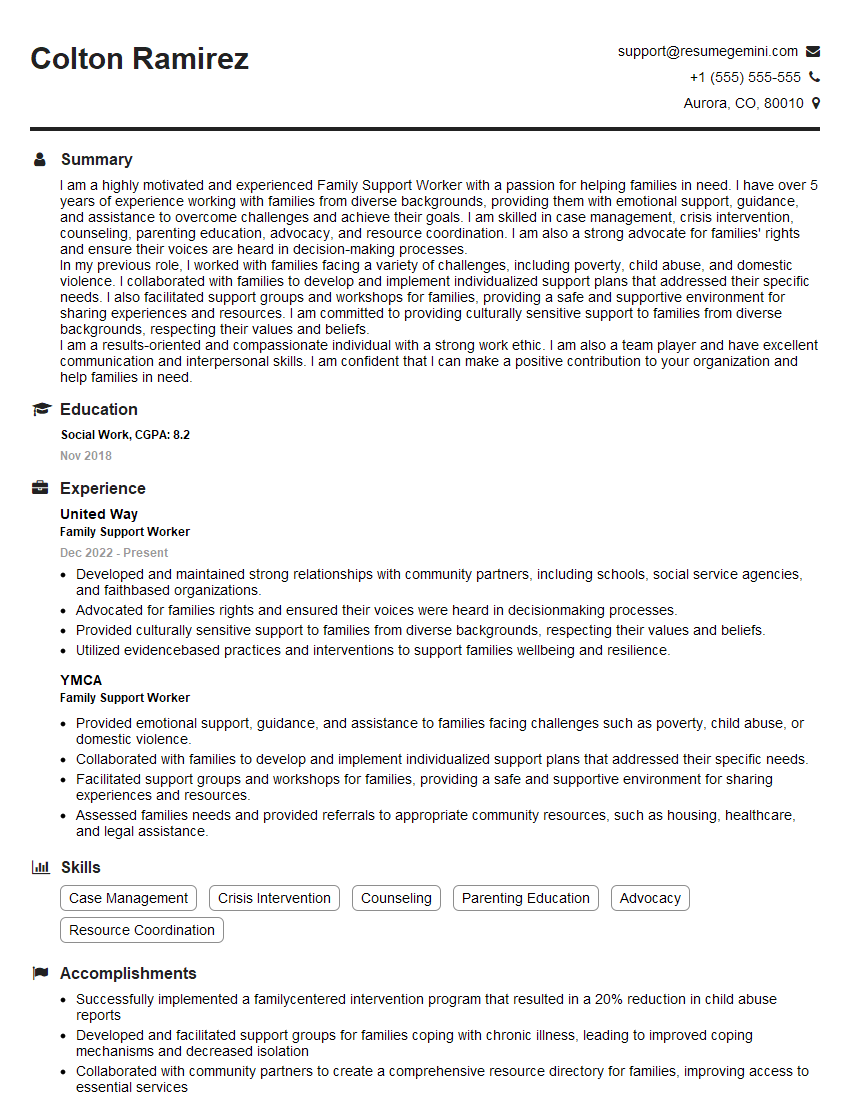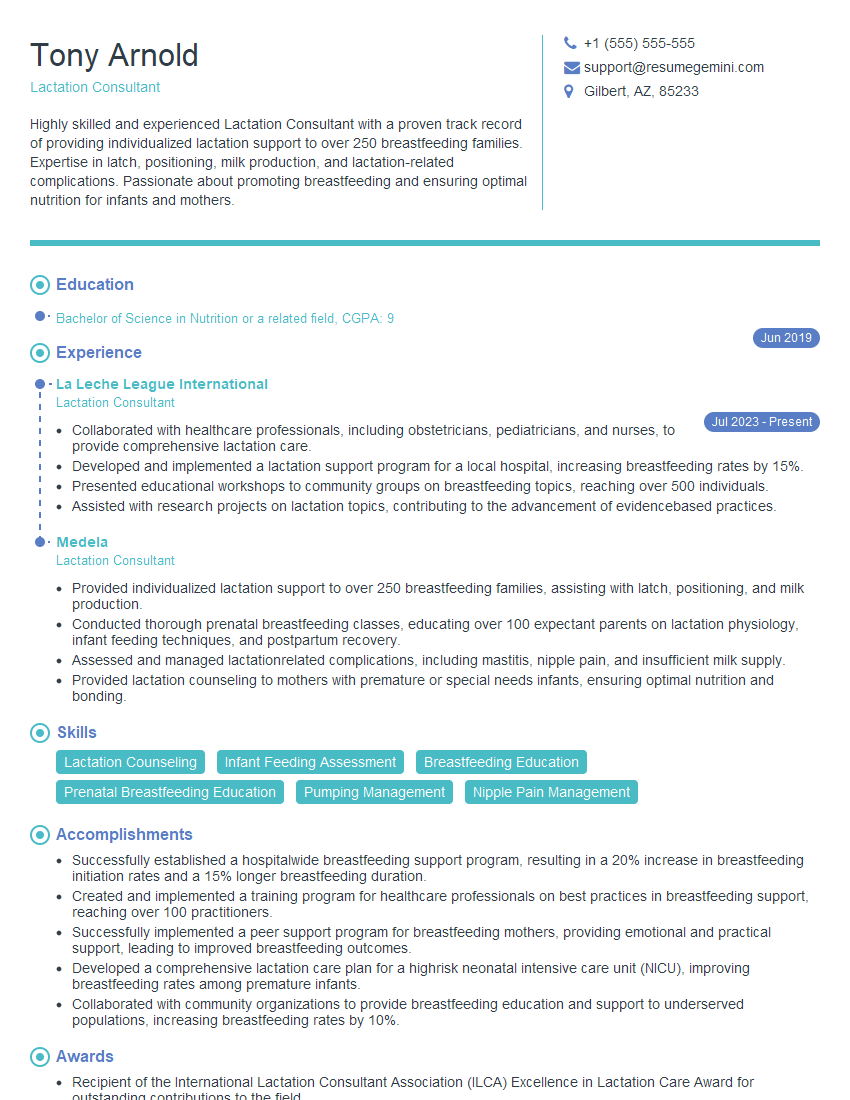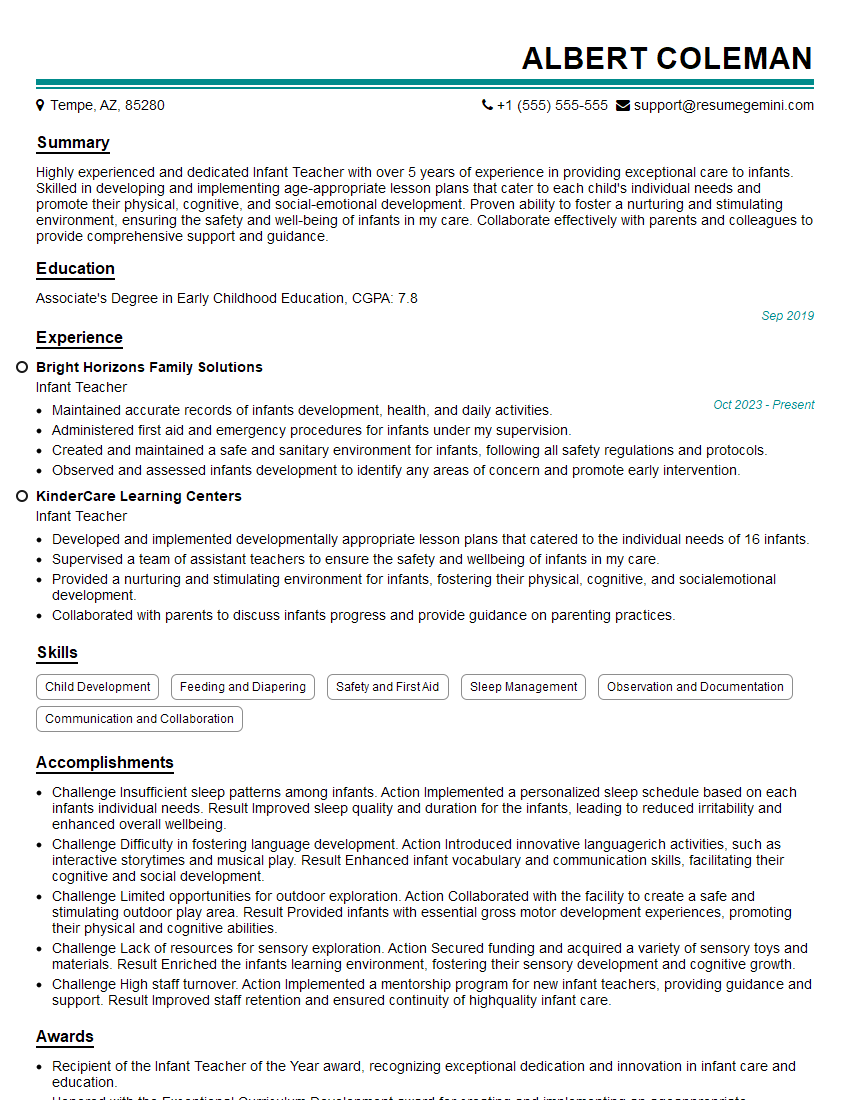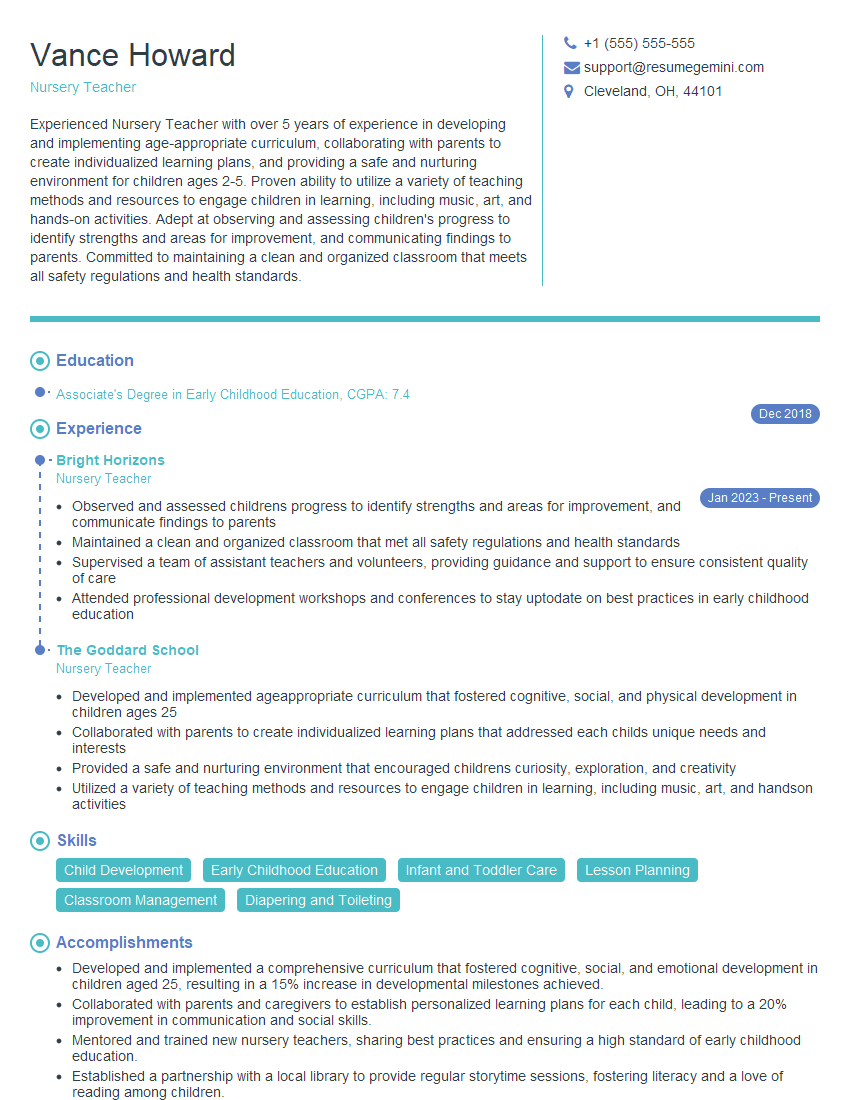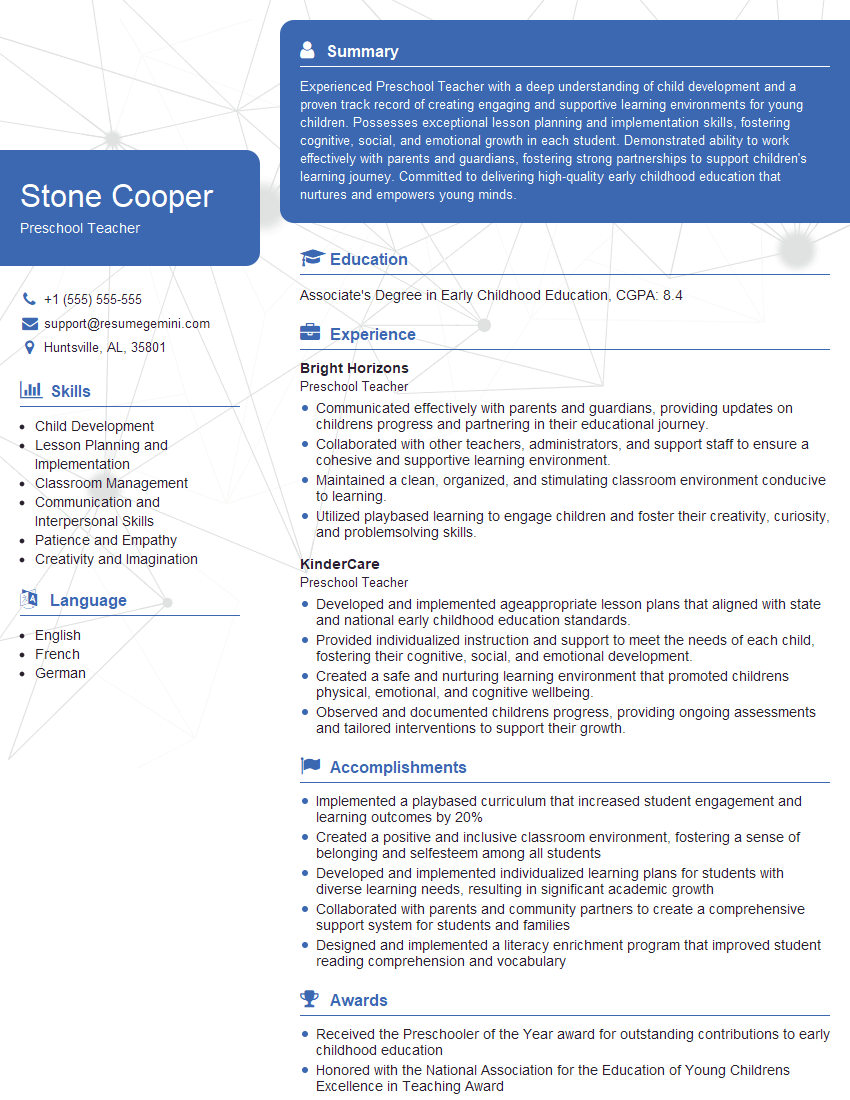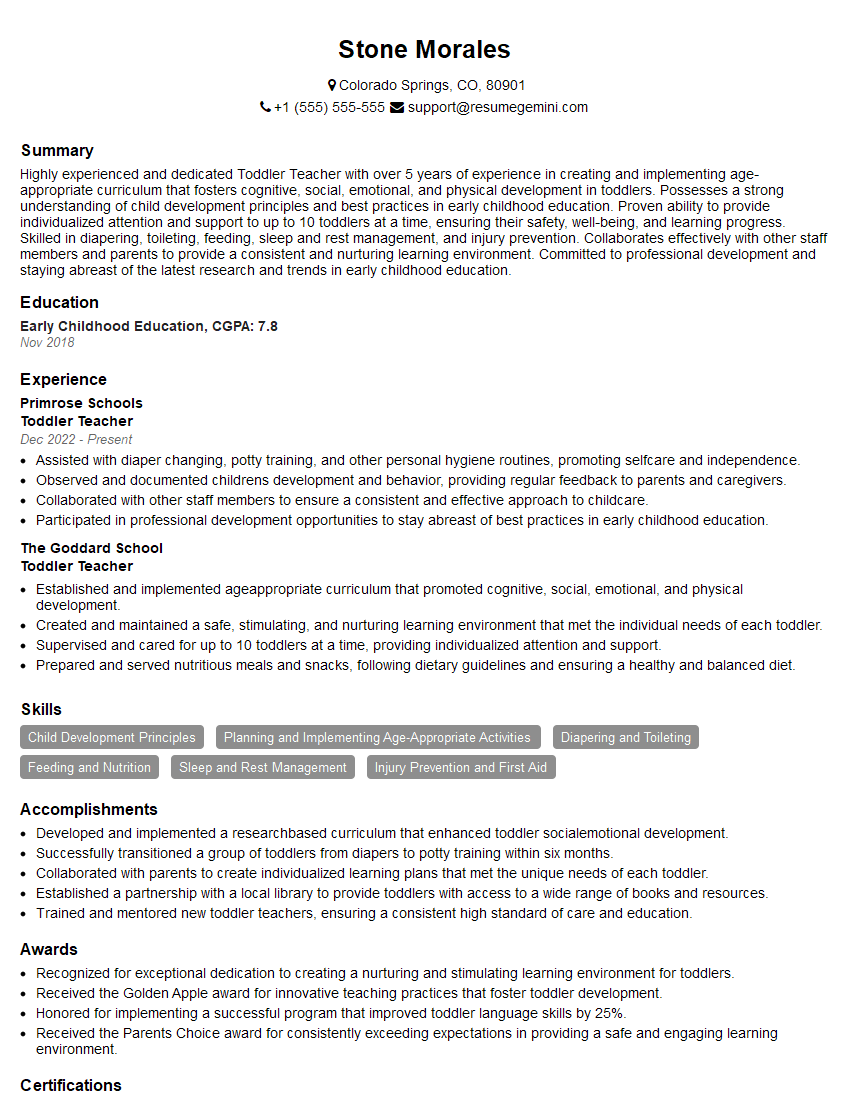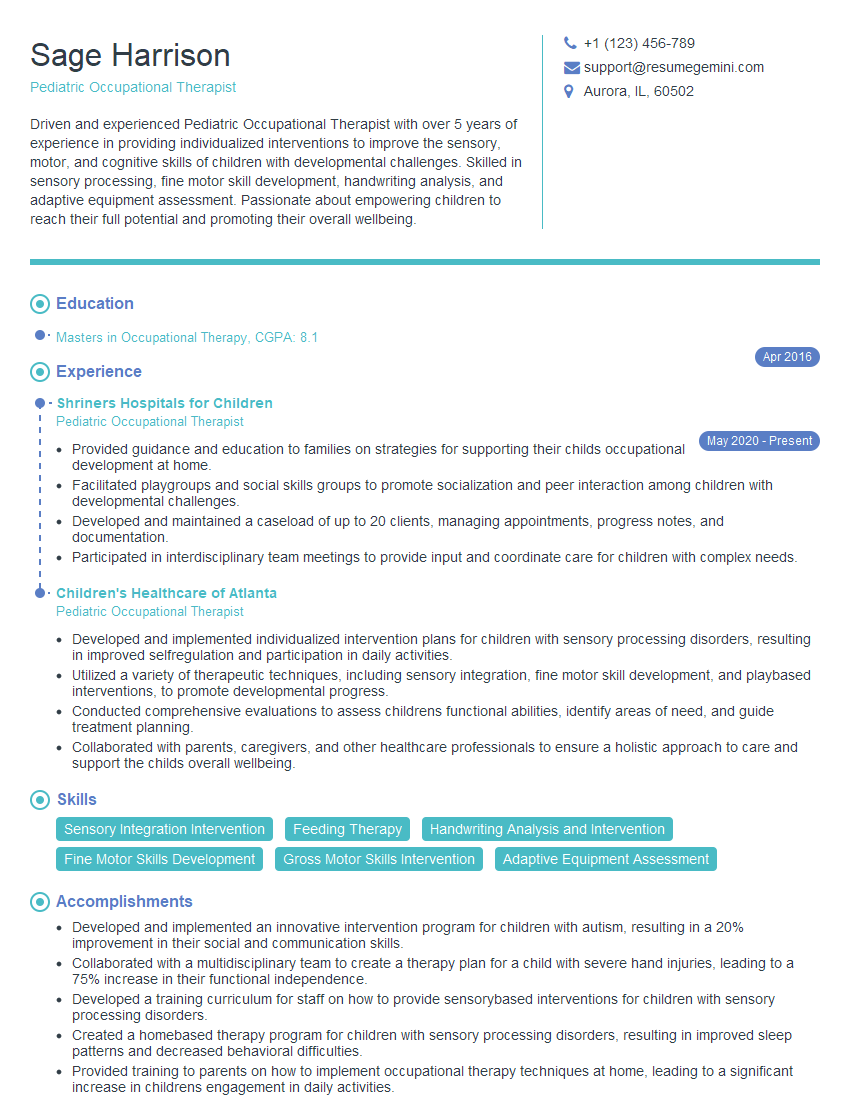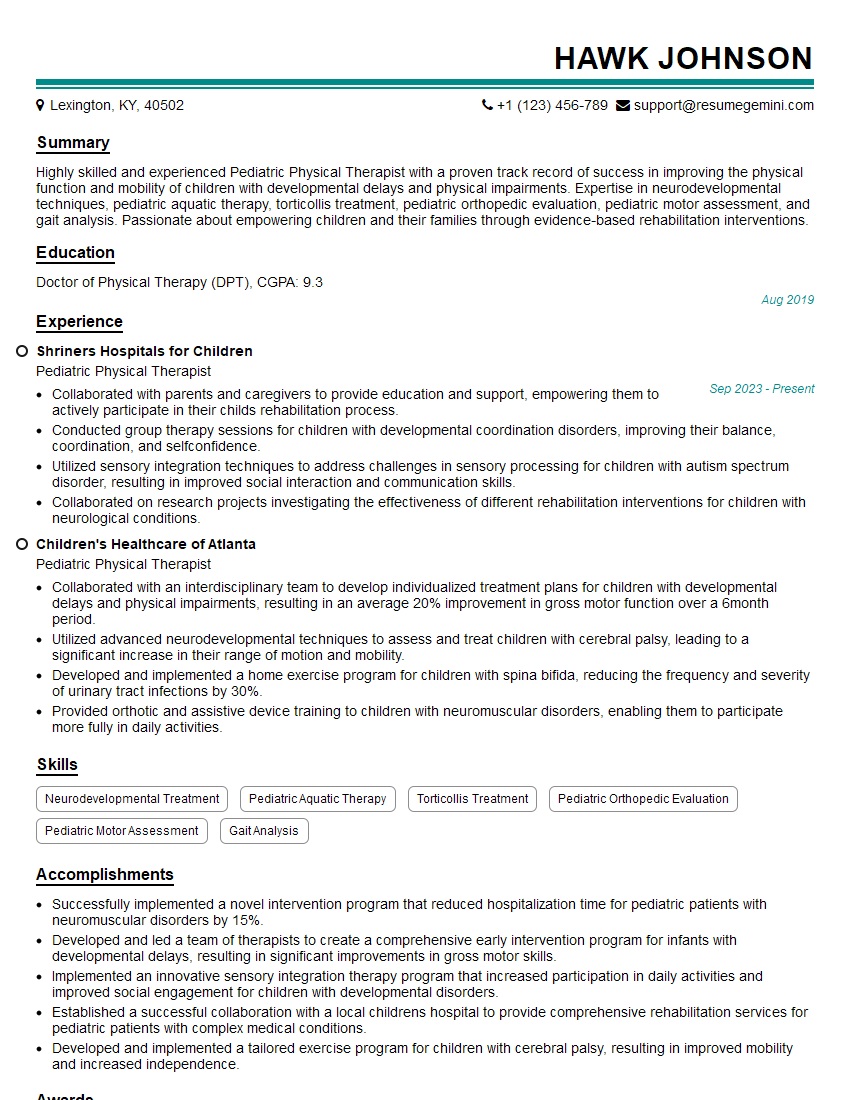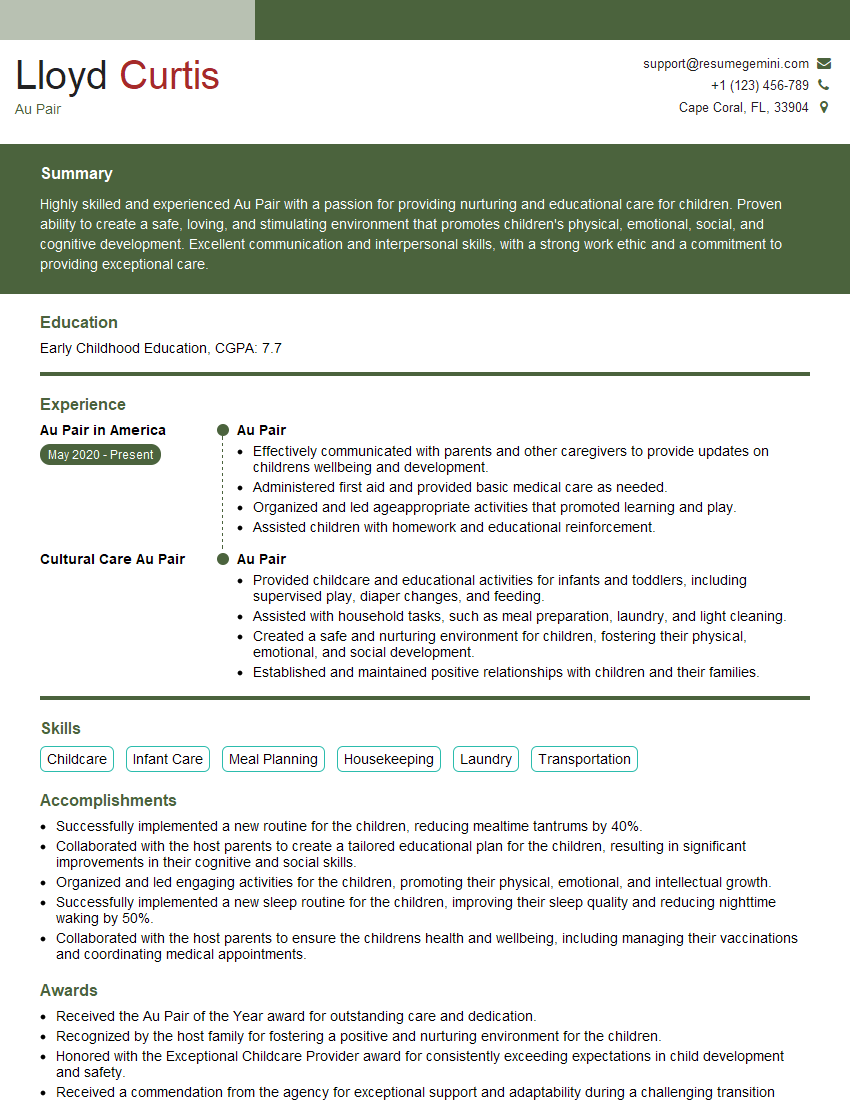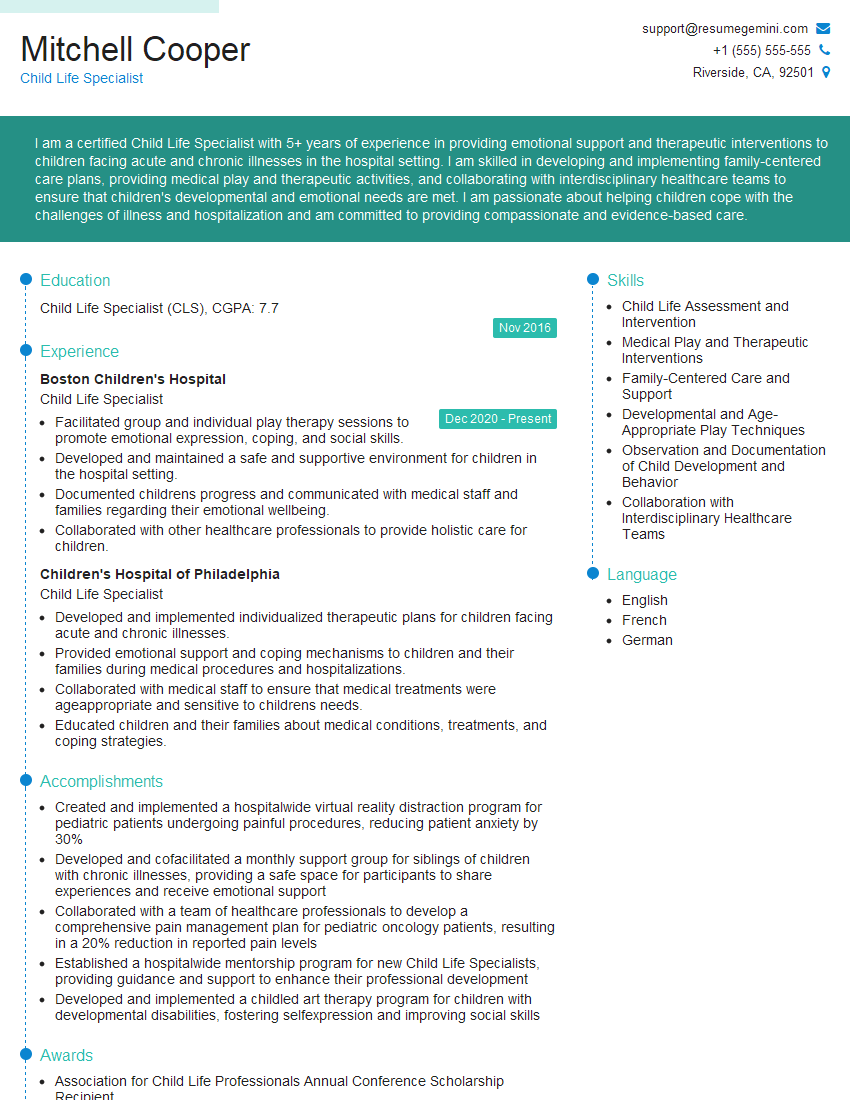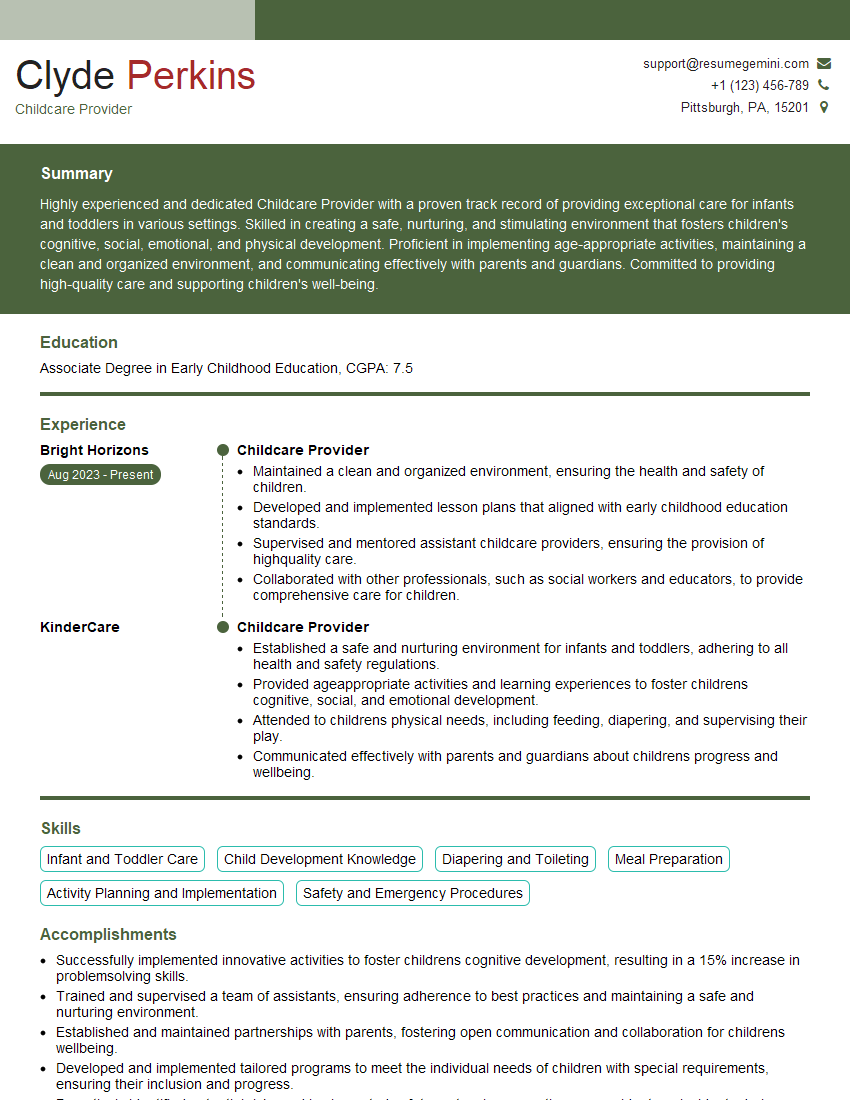The thought of an interview can be nerve-wracking, but the right preparation can make all the difference. Explore this comprehensive guide to Infant and Toddler Development interview questions and gain the confidence you need to showcase your abilities and secure the role.
Questions Asked in Infant and Toddler Development Interview
Q 1. Describe the key developmental milestones for infants aged 0-3 months.
The first three months of an infant’s life are a period of rapid growth and development, marked by significant changes in various domains. Think of it as laying the foundation for all future development.
- Physical Development: Infants will likely gain weight and grow in length. They start to hold their heads up briefly when supported, and their reflexes, such as the Moro reflex (startle reflex), become more integrated. They also begin to track objects with their eyes, and you may see them briefly grasp objects placed in their hands.
- Sensory Development: Their senses are becoming more refined. They start to differentiate between sounds, show preference for sweet tastes, and are increasingly responsive to touch and visual stimuli. Think of the joy they show when seeing a parent’s face.
- Social and Emotional Development: Infants start to show social smiles, often in response to faces and voices they recognize. They begin to engage in periods of quiet alertness, indicating they are processing their surroundings. They also exhibit calming behaviors like sucking on their fingers for self-soothing.
- Cognitive Development: While early cognitive development is subtle, you can observe an increasing focus on stimuli and attention span improvements. They begin to show signs of object permanence, understanding that an object still exists even if they can’t see it.
For example, a healthy three-month-old might smile in response to you, lift their head momentarily when placed on their tummy, and follow your finger with their eyes as you move it across their visual field. Any significant deviation from these milestones should be discussed with a pediatrician.
Q 2. What are the typical signs of language development in toddlers?
Language development in toddlers is a fascinating journey! It’s not just about words, but understanding and using them. We see significant progress from simple sounds to complex sentences. Here are some typical signs:
- Babbling: Around 6-8 months, babbling increases, with sounds becoming more varied and resembling speech. Think of the ‘ba-ba-ba’ or ‘ma-ma-ma’ sounds.
- First Words: Usually around 12 months, toddlers utter their first words, often referring to people or objects important to them, like “mama,” “dada,” or “ball.”
- Gestures: Toddlers often use gestures like pointing or waving to communicate their needs and desires before developing sufficient vocabulary.
- Understanding Simple Instructions: They start understanding simple commands like “give me the toy” or “come here.”
- Word Combinations: By 18-24 months, they combine words into simple phrases, like “Mommy go” or “drink juice.”
- Following Simple Directions: They follow simple, two-step directions by this age.
Remember that each child develops at their own pace. While some might hit these milestones early, others might take a little longer. What’s crucial is observing the overall developmental trajectory and addressing concerns if a child consistently lags behind. For instance, a toddler who isn’t babbling by 12 months or using any words by 18 months might warrant further investigation.
Q 3. Explain the importance of attachment in infant development.
Attachment refers to the special bond between a child and their primary caregiver(s). It’s a crucial aspect of infant development; it’s the bedrock for their emotional, social, and cognitive development. Think of it as building a safe base from which they can explore the world.
- Secure Attachment: Children with secure attachment feel safe and confident in their caregiver’s responsiveness. This allows them to explore their environment freely, knowing they have a secure base to return to. This often leads to better social skills, emotional regulation, and academic success.
- Insecure Attachment: Insecure attachment can stem from inconsistent caregiving or trauma. It can manifest as anxiety, avoidance, or a disorganized attachment style, impacting their future relationships and emotional well-being. For example, a child might become overly clingy or avoidant towards their caregiver.
The quality of attachment significantly impacts future relationships, emotional regulation, and even their overall mental health. A child with secure attachment typically develops a stronger sense of self, better coping mechanisms, and healthier social relationships.
Q 4. How would you handle a toddler experiencing a temper tantrum?
Temper tantrums are a normal part of toddlerhood. They’re a manifestation of their limited communication skills and emotional regulation. The key is to respond calmly and consistently. Avoid punishment, as this can worsen the situation and damage the relationship.
- Stay Calm: Your calm demeanor can help de-escalate the situation. Try to remain patient and understanding.
- Ensure Safety: Make sure the child is safe from harm, both to themselves and others. Remove them from unsafe situations, if necessary.
- Ignore the Behavior (if safe): Often, the attention they get reinforces the tantrum. If the behavior isn’t dangerous, ignoring it might be effective.
- Offer Comfort and Reassurance Once Calmed: Once the tantrum subsides, offer comfort and reassurance. Let them know you’re there for them.
- Positive Reinforcement: When they exhibit calm behavior, praise and reward them. This strengthens positive behavior.
For example, if a toddler is throwing a tantrum because they can’t have a cookie, ignoring the behavior (if the tantrum isn’t unsafe) might be more effective than engaging with it. Once calm, you could discuss the reason behind the no-cookie policy and offer a healthy alternative.
Q 5. What strategies do you use to promote healthy eating habits in toddlers?
Promoting healthy eating habits in toddlers involves a holistic approach, focusing on positive experiences and education rather than coercion.
- Variety is Key: Offer a wide variety of healthy foods from all food groups. Repeated exposure to new foods can increase acceptance.
- Role Modeling: Children often imitate their caregivers’ behaviors. By modeling healthy eating habits, you set a positive example.
- Positive Reinforcement: Focus on praise and encouragement, rather than punishment. Celebrating small victories, like trying a new vegetable, can boost their confidence.
- Involve Them in Food Preparation: Letting them help wash vegetables or set the table can foster a positive relationship with food.
- Make it Fun: Cut sandwiches into fun shapes, serve colorful fruits and vegetables, or use creative meal presentations to make eating more appealing.
- Avoid Power Struggles: Avoid forcing children to eat. Instead, focus on offering healthy options and letting them choose from a selection.
For instance, instead of saying ‘Eat your broccoli!’, you could say, ‘Let’s see how many little trees (broccoli florets) we can eat!’ Making it a game can greatly increase acceptance.
Q 6. Discuss the role of play in early childhood development.
Play is not just fun; it’s essential for early childhood development. It’s how children learn, grow, and develop crucial skills. Think of it as their primary mode of learning and exploration.
- Cognitive Development: Play enhances problem-solving skills, creativity, and critical thinking. Building blocks, puzzles, and pretend play all contribute to this development.
- Social and Emotional Development: Play provides opportunities for social interaction, cooperation, negotiation, and emotional expression. Playing with peers teaches sharing, empathy, and conflict resolution.
- Physical Development: Active play strengthens gross motor skills (running, jumping) and fine motor skills (using crayons, building with blocks).
- Language Development: Play often involves communication, encouraging language acquisition and vocabulary expansion. Pretend play, in particular, can expand their vocabulary and understanding of different situations.
For example, playing with building blocks helps develop spatial reasoning and problem-solving skills. Pretend play, like playing doctor or house, promotes social skills, emotional expression, and language development. The types of play available are crucial to maximizing developmental gains.
Q 7. How would you create a safe and stimulating learning environment for infants?
Creating a safe and stimulating learning environment for infants involves careful planning to cater to their developmental needs and safety. It’s all about creating a space that encourages exploration and development without compromising safety.
- Safety First: Ensure the environment is free from hazards like sharp objects, choking hazards, and electrical cords. Baby-proof the area thoroughly.
- Sensory Stimulation: Include various textures, colors, and sounds. Rattles, soft toys, and textured blankets provide sensory input.
- Visual Stimulation: Hang mobiles with contrasting colors and patterns, or place colorful objects within their reach.
- Opportunities for Movement: Provide a safe space for tummy time to strengthen neck and back muscles. Use playmats or soft surfaces.
- Interaction and Engagement: Spend quality time interacting with the infant, talking, singing, and playing games. Respond to their cues and encourage their communication.
- Age-Appropriate Toys: Choose toys that are safe, stimulating, and appropriate for their developmental stage.
For example, a safe and stimulating environment might include a playmat with different textures, a mobile with colorful patterns, and age-appropriate toys like rattles and soft blocks. The space should be designed to encourage movement and exploration while maintaining safety.
Q 8. Explain different parenting styles and their impact on child development.
Parenting styles significantly influence a child’s development. Four main styles are often discussed: Authoritative, Authoritarian, Permissive, and Uninvolved.
- Authoritative: This style combines high responsiveness (warmth, empathy, and understanding) with high demandingness (setting clear expectations and rules). Children raised with this style tend to be self-reliant, responsible, and socially competent. Think of it as a balanced approach, offering both love and guidance. For example, an authoritative parent might explain the reasons behind a rule like bedtime, rather than simply enforcing it.
- Authoritarian: High demandingness, low responsiveness. Rules are strictly enforced with little explanation or emotional support. Children may become anxious, withdrawn, or rebellious. Imagine a parent who demands obedience without providing reasons or showing affection.
- Permissive: High responsiveness, low demandingness. Parents are loving and supportive but set few limits or rules. Children may struggle with self-control, impulsivity, and responsibility. This could look like a parent who always gives in to their child’s demands.
- Uninvolved: Low responsiveness, low demandingness. Parents are detached and provide little guidance or emotional support. Children may exhibit behavioral problems, low self-esteem, and poor academic performance. This is the most detrimental style, reflecting a lack of parental involvement.
It’s important to remember that these are idealized styles; most parents exhibit a blend of characteristics. The key is finding a balance that fosters a secure attachment and allows children to develop a strong sense of self.
Q 9. What are some common sleep problems in infants and how would you address them?
Sleep problems are very common in infants. These can include difficulties falling asleep, frequent nighttime wakings, early morning wakings, and short sleep duration. Addressing these requires a multi-faceted approach:
- Establish a consistent bedtime routine: A calming routine (bath, book, song) signals the body it’s time to sleep. Consistency is key.
- Create a conducive sleep environment: A dark, quiet, and cool room is ideal. White noise machines can help mask disruptive sounds.
- Safe sleep practices: Always place the baby on their back to sleep on a firm surface, without loose bedding or toys.
- Addressing feeding issues: Ensure the baby is adequately fed before bedtime. Overfeeding or underfeeding can disrupt sleep.
- Addressing medical concerns: Rule out any underlying medical conditions (reflux, allergies, etc.) that might be causing sleep disturbances. Consult your pediatrician.
- Sleep training methods: Gradual extinction, Ferber method, or positive reinforcement methods can be helpful, but should be tailored to the individual child and family and used cautiously. Consult a child sleep specialist for guidance.
It’s crucial to remember that every baby is different and what works for one might not work for another. Patience and consistency are key to success. If sleep problems persist despite implementing these strategies, seeking professional help is recommended.
Q 10. How do you assess a child’s developmental progress?
Assessing a child’s developmental progress involves a multifaceted approach. We utilize standardized developmental screening tools, observation, and parental input.
- Standardized screening tools: These are questionnaires or assessments (like the Ages and Stages Questionnaires or the Denver Developmental Screening Test) that help identify potential delays in areas such as gross motor skills (crawling, walking), fine motor skills (grasping, drawing), language (speaking, understanding), and social-emotional development (interaction, emotional regulation). These are not diagnostic tools but rather flags for further investigation.
- Observation: Observing the child’s play, interaction with others, and daily activities provides valuable insights into their development. I look for spontaneous actions and behaviors to gauge their abilities.
- Parental input: Parents are the best source of information regarding their child’s behavior and development. Their observations and concerns are invaluable in forming a complete picture.
Based on this combined information, we can determine if the child is developing appropriately for their age or if further assessment or intervention is needed. Early intervention is crucial if a delay is identified.
Q 11. Describe your experience with potty training toddlers.
Potty training is a significant developmental milestone, and success varies greatly depending on the child’s readiness and the parent’s approach.
My experience emphasizes a child-led approach rather than a strict timeline. I work with families to recognize signs of readiness, including:
- Physical readiness: The child can stay dry for longer periods, understands the concept of needing to use the toilet, and can pull their pants up and down.
- Cognitive readiness: The child shows an interest in the toilet or potty, understands basic instructions, and can communicate their needs.
- Emotional readiness: The child is generally cooperative and willing to participate in the process.
Once these signs are evident, I encourage positive reinforcement, praising successes and providing encouragement. Accidents happen, and it’s crucial to react calmly and avoid punishment. Patience and consistency are key. Every child develops at their own pace, and celebrating small victories is vital for a positive experience. Open communication between parents and me ensures we work collaboratively to manage the process.
Q 12. How do you manage challenging behaviors in toddlers?
Managing challenging behaviors in toddlers requires understanding the underlying cause. Toddlers are still developing self-regulation skills and often exhibit behaviors as a means of communication.
- Identify the trigger: What situations or events lead to the challenging behavior? Hunger, fatigue, or frustration are common culprits.
- Positive reinforcement: Praise and reward desired behaviors. Ignoring minor attention-seeking behaviors (unless unsafe) can often be effective.
- Consistency: Establish clear rules and consequences. Consistency helps children understand expectations.
- Time-outs: Short, supervised time-outs can be used for calming down, but should be age-appropriate and not punitive.
- Emotional coaching: Help toddlers label and understand their feelings. Teaching coping mechanisms like deep breathing or taking a break can be beneficial.
- Seek professional help: If behaviors are severe or persistent, seeking guidance from a child psychologist or therapist is recommended.
It is vital to remember to react calmly and avoid punishment. Building a strong parent-child relationship based on trust and empathy is crucial in addressing challenging behaviors. Strategies should be individualized to the specific child and the context of the behavior.
Q 13. What are some signs of developmental delays in infants and toddlers?
Developmental delays can manifest in various ways. Early identification is critical for timely intervention.
- Gross motor delays: Significant delays in achieving milestones like rolling over, sitting, crawling, or walking.
- Fine motor delays: Difficulty with grasping objects, using utensils, or drawing.
- Language delays: Limited vocabulary, difficulty understanding speech, or absence of babbling/cooing at the appropriate age.
- Social-emotional delays: Lack of eye contact, limited social interaction, difficulty expressing emotions, or excessive clinginess.
- Cognitive delays: Slow learning, difficulty with problem-solving, or attention deficits.
If you have concerns about your child’s development, consulting with your pediatrician or a developmental specialist is crucial. Early intervention can make a significant difference in a child’s development and future outcomes. Remember, early intervention is key.
Q 14. How would you adapt your teaching methods to meet the needs of diverse learners?
Adapting teaching methods for diverse learners is paramount. I incorporate several strategies:
- Differentiated instruction: Providing different learning experiences based on individual needs. This might include varied activities, materials, or levels of support.
- Multi-sensory learning: Utilizing different senses (visual, auditory, kinesthetic, tactile) to engage diverse learning styles.
- Individualized learning plans (ILPs): Tailoring teaching to address specific learning needs or goals.
- Inclusive classroom environment: Creating a welcoming space where all children feel valued and respected, regardless of their abilities or backgrounds.
- Collaboration with specialists: Working closely with other professionals like occupational therapists, speech therapists, or special education teachers to ensure comprehensive support.
- Utilizing assistive technologies: Incorporating technology to support learning needs, such as visual aids, communication apps, or adaptive equipment.
Understanding each child’s strengths and challenges allows me to adjust my approach, ensuring all learners can reach their full potential. A flexible and adaptable teaching style is crucial for meeting the diverse needs of young children.
Q 15. Explain your understanding of child abuse and neglect reporting procedures.
Child abuse and neglect reporting is a crucial aspect of protecting vulnerable children. My understanding encompasses mandatory reporting laws, which legally require professionals like myself to report any suspected instances of abuse or neglect to the appropriate authorities. This isn’t about making accusations; it’s about ensuring children’s safety. The process usually involves contacting the designated child protective services agency or law enforcement. I’m trained to recognize signs of abuse – physical injuries, unexplained bruises, neglectful hygiene, emotional withdrawal, behavioral changes – and to document these observations meticulously. My reporting includes a detailed account of my concerns, including specific dates, times, and observations, always prioritizing the child’s well-being. It’s essential to maintain confidentiality while adhering strictly to the legal requirements and maintaining accurate records. I also understand the importance of collaborating with other professionals, such as social workers and law enforcement, to ensure a coordinated response.
For example, if I observed a child repeatedly arriving to school with unexplained bruises or consistently exhibiting signs of significant emotional distress, I would immediately document these observations and contact the mandated child protective services agency in accordance with local guidelines. The wellbeing of the child would always be my top priority.
Career Expert Tips:
- Ace those interviews! Prepare effectively by reviewing the Top 50 Most Common Interview Questions on ResumeGemini.
- Navigate your job search with confidence! Explore a wide range of Career Tips on ResumeGemini. Learn about common challenges and recommendations to overcome them.
- Craft the perfect resume! Master the Art of Resume Writing with ResumeGemini’s guide. Showcase your unique qualifications and achievements effectively.
- Don’t miss out on holiday savings! Build your dream resume with ResumeGemini’s ATS optimized templates.
Q 16. Describe your experience working with children with special needs.
I have extensive experience working with children with diverse special needs, ranging from developmental delays and learning disabilities to autism spectrum disorder and sensory processing sensitivities. My approach is always individualized, focusing on each child’s unique strengths and challenges. I believe in creating a supportive and inclusive environment where every child feels valued and can thrive. This involves collaborating closely with therapists, specialists, and parents to develop and implement individualized education programs (IEPs) or individualized family service plans (IFSPs).
For instance, I worked with a child diagnosed with autism who struggled with social interaction and sensory overload. We implemented strategies like visual schedules, quiet corners for sensory breaks, and structured activities to help him regulate his emotions and participate more effectively in the classroom. We celebrated even the smallest successes to build his self-esteem and confidence. This required patience, understanding, and a willingness to adapt my teaching methods to meet his specific needs. The collaboration with his parents and therapists was integral to his progress.
Q 17. How do you promote social-emotional development in infants and toddlers?
Promoting social-emotional development in infants and toddlers is foundational for their future well-being. It involves creating a nurturing and responsive environment where they feel safe, secure, and understood. This begins with building strong, consistent relationships with each child, providing ample opportunities for social interaction, and teaching emotional regulation skills.
- Secure Attachment: Responsive caregiving, meeting their needs promptly and consistently, is crucial for establishing a secure attachment, the cornerstone of healthy social-emotional development.
- Social Interaction: Providing opportunities for playdates, group activities, and interaction with peers helps children learn social skills such as sharing, cooperation, and conflict resolution.
- Emotional Regulation: Teaching children to identify and express their emotions in healthy ways is crucial. This can involve modeling appropriate emotional responses, providing a vocabulary of emotions, and teaching calming techniques.
- Positive Reinforcement: Praising and rewarding positive behaviors reinforces desired social-emotional skills.
For example, using puppets or role-playing to discuss feelings, teaching calming techniques like deep breathing, and providing a calm and consistent routine all contribute to fostering healthy social-emotional development. A calm and predictable classroom environment is essential for young children to feel safe and secure.
Q 18. How do you foster a positive parent-teacher relationship?
Fostering a positive parent-teacher relationship is paramount for a child’s success. Open communication, mutual respect, and shared goals are key. I believe in establishing a partnership built on trust and transparency.
- Regular Communication: Frequent communication, through newsletters, daily reports, parent-teacher conferences, and informal conversations, keeps parents informed about their child’s progress and any concerns.
- Active Listening: Actively listening to parents’ perspectives and concerns validates their input and builds trust.
- Collaboration: Working collaboratively with parents to develop strategies for supporting their child’s development at home and school ensures consistency and reinforces learning.
- Positive Feedback: Sharing both positive achievements and areas for growth in a constructive way helps parents feel involved and supported.
For example, I regularly share anecdotal notes or short videos with parents showcasing their child’s progress and achievements in a specific area. This proactive communication approach strengthens the parent-teacher bond.
Q 19. What are some effective strategies for managing classroom transitions?
Managing classroom transitions smoothly in an infant and toddler setting requires careful planning and consistent routines. Transitions are often challenging for young children, so predictability and clear expectations are key.
- Visual Cues: Using visual aids like timers, picture schedules, or transition songs helps children understand what’s coming next and prepares them for the change.
- Clear Instructions: Giving simple, clear instructions, repeated as needed, reduces confusion and anxiety.
- Routines: Establishing consistent routines for transitions creates predictability and reduces stress.
- Engaging Activities: Employing brief, engaging activities during transitions, such as singing songs or doing a short movement activity, helps keep children focused and involved.
- Positive Reinforcement: Praising children for successfully navigating transitions encourages cooperation and positive behavior.
For example, before transitioning from free play to circle time, we might start a transition song that cues children to start cleaning up. This provides a clear signal and keeps the transition fun and engaging.
Q 20. How do you incorporate sensory activities into your lesson plans?
Incorporating sensory activities into lesson plans is essential for promoting cognitive, social-emotional, and physical development in infants and toddlers. Sensory play allows children to explore the world through their senses, enhancing their understanding of their environment.
- Touch: Playdough, finger painting, textured materials.
- Sight: Brightly colored toys, light tables, picture books.
- Sound: Musical instruments, singing, environmental sounds.
- Smell: Scented playdough, essential oils (used cautiously and appropriately).
- Taste: (Always supervised and with safe, edible materials) Tasting different foods, exploring textures.
For example, a lesson might involve making homemade playdough with different textures (smooth, bumpy, sticky), introducing new smells like cinnamon or vanilla, and then using the playdough to create shapes while singing a simple song. This multi-sensory approach enhances learning and engagement.
Q 21. Describe your experience with curriculum planning and implementation.
Curriculum planning and implementation in infant and toddler education requires a developmentally appropriate approach. I begin by identifying the children’s individual needs and interests, aligning the curriculum with established developmental milestones and best practices. The curriculum should be flexible, responsive to the children’s needs, and play-based.
- Developmental Milestones: The curriculum should address key developmental milestones in areas like language, cognitive, social-emotional, and physical development, adapting to the diverse learning styles and needs of the children.
- Theme-Based Units: Utilizing theme-based units provides a structure for lessons, allowing for in-depth exploration of specific topics and integration of different learning areas.
- Assessment: Ongoing, informal assessment through observation and documentation helps to track individual progress and inform future planning.
- Collaboration: Close collaboration with colleagues and specialists ensures alignment of efforts and addresses diverse learning needs.
For example, a theme-based unit on “animals” might incorporate songs about animals, creating animal masks, reading animal-themed books, and engaging in imaginative play with animal figurines. This holistic approach allows for multiple learning experiences within a single unit.
Q 22. How would you respond to a parent’s concern about their child’s development?
My approach to a parent’s developmental concern begins with active listening and empathy. I’d start by asking open-ended questions to understand their specific worry, for example, ‘Can you tell me more about what concerns you about [child’s name]’s development?’ This helps me gather all the relevant information. Then, I carefully observe the child’s behavior and developmental milestones, comparing them to established norms. I’d never offer a diagnosis, but I would share my observations objectively, using age-appropriate developmental charts as a reference point. If my observations suggest a potential developmental delay or concern, I would recommend a consultation with a pediatrician or other relevant specialist, emphasizing the importance of early intervention. I would also provide the parent with resources and support, including websites, books, and local organizations that offer developmental guidance. I believe in collaborative parenting and would work closely with the parents to create a supportive plan tailored to their child’s unique needs.
For example, if a parent expresses concern about their 18-month-old’s speech, I would first assess the child’s language abilities in a playful setting. If they seem behind, instead of saying ‘Your child is behind,’ I might say, ‘While many 18-month-olds are saying several words, we can explore strategies to encourage language development at home.’ I might then offer tips like reading aloud frequently, engaging in interactive play, and singing songs together. Finally, I would clearly explain the importance of seeking professional advice from their pediatrician or a speech therapist.
Q 23. What are your strategies for maintaining a clean and hygienic environment for infants and toddlers?
Maintaining a clean and hygienic environment for infants and toddlers is paramount for preventing illness and promoting their well-being. My strategies are multifaceted and incorporate frequent cleaning and disinfection practices, coupled with good hand hygiene. We establish regular cleaning schedules for all surfaces, toys, and equipment, using age-appropriate and environmentally friendly cleaning solutions. Diaper changing areas are disinfected after each use, and handwashing facilities are readily accessible. Infants and toddlers are taught the importance of handwashing through songs, games, and positive reinforcement. We emphasize proper handwashing techniques – using soap and water for at least 20 seconds. Food preparation areas are meticulously cleaned and disinfected, and food is handled following safe food handling practices. All bedding and clothing are washed regularly using hypoallergenic detergents. We also implement strict protocols for handling spills and accidents, ensuring prompt and thorough cleaning to prevent the spread of germs.
For instance, we use color-coded cleaning cloths to prevent cross-contamination: one color for toilets, another for high chairs, and so on. This system ensures the cleanliness of different areas. We also regularly sanitize frequently touched surfaces like door handles and toys with age-appropriate disinfectants.
Q 24. How do you ensure the safety and well-being of children in your care?
Ensuring the safety and well-being of children is my top priority. This involves creating a secure and stimulating environment that minimizes potential hazards. We perform regular safety checks of the premises, ensuring that all electrical outlets are covered, furniture is stable, and potential choking hazards are removed. All toys are age-appropriate and regularly inspected for damage. We implement strict supervision ratios, ensuring adequate adult-to-child ratios to prevent accidents and injuries. Clear safety guidelines and procedures are established and communicated to staff and parents. We conduct regular safety training for all staff members, covering topics such as first aid, CPR, and emergency response procedures. Furthermore, we maintain detailed accident and incident reports for continuous improvement and better safety practices. We also make sure all emergency contact information is up-to-date and readily accessible.
For example, we utilize child-proof locks on cabinets containing cleaning supplies and medications and ensure that all outdoor play areas are fenced and regularly inspected for potential dangers like broken glass or sharp objects. We teach children about safety, such as looking both ways before crossing a street during outdoor activities. We also frequently review and update our safety procedures based on industry best practices and new research.
Q 25. Describe your experience with emergency procedures in a childcare setting.
I have extensive experience with emergency procedures in a childcare setting. I’m certified in CPR and First Aid, and I have participated in numerous emergency drills, including fire evacuations, lockdown procedures, and medical emergency response. My training emphasizes swift and decisive action in crisis situations. We have well-defined emergency protocols, including detailed evacuation plans, communication systems, and emergency contact lists. All staff members are familiar with these procedures and know their roles and responsibilities in an emergency. We regularly practice these drills to ensure that everyone is prepared and that our response is efficient and effective. We maintain a well-stocked first aid kit and are adept at handling minor injuries, such as cuts and scrapes. In the event of a major medical emergency, we immediately call emergency services and follow their instructions.
For instance, during a fire drill, we ensure all children are accounted for and safely evacuated following a pre-determined route. Each staff member has a designated role, including gathering children and assisting them to safety, and ensuring all children are escorted to the designated assembly point. Following a drill, we conduct a debriefing session to identify any areas of improvement and to reinforce the importance of safety measures.
Q 26. What are your professional development goals in the field of early childhood education?
My professional development goals center around enhancing my expertise in infant and toddler development and creating innovative learning environments. I plan to pursue advanced training in trauma-informed care, which I believe is crucial for supporting children who may have experienced adverse experiences. I’m also interested in exploring the integration of technology in early childhood education, focusing on age-appropriate and developmentally beneficial applications. I intend to deepen my understanding of different learning styles and approaches, particularly those supporting children with diverse learning needs. I believe in continuous learning and staying abreast of the latest research and best practices in early childhood education. To that end, I actively participate in professional development workshops and conferences, and regularly read relevant journals and publications.
Specifically, I want to obtain a certification in trauma-informed care within the next year, and to attend at least one relevant conference each year to keep updated on new practices.
Q 27. How do you handle conflicts between children?
Conflict resolution between children is a key aspect of my role. My approach is centered on teaching children conflict resolution skills, rather than simply stopping the conflict. I intervene calmly and objectively, helping children understand each other’s perspectives. I guide them towards finding solutions through negotiation and compromise, emphasizing empathy and respect. I teach them to use their words to express their feelings and needs, and I model appropriate conflict-resolution strategies. I focus on helping children understand the consequences of their actions and the importance of repairing relationships. I believe in restorative justice approaches, which focus on repairing harm and restoring relationships rather than simply punishing wrongdoing. I avoid taking sides and ensure fairness to all involved.
For example, if two children are fighting over a toy, I would guide them to communicate their wants. Instead of simply giving the toy to one of them, I would work with them to find alternative solutions, like taking turns with the toy or finding another similar toy. The focus is always on teaching them how to resolve conflicts themselves and learn from the experience.
Q 28. What are your preferred methods for communicating with parents?
Effective communication with parents is crucial for building trust and collaboration. My preferred methods include regular face-to-face interactions, daily or weekly communication logs, email updates, and parent-teacher conferences. I believe in open and honest communication, providing parents with regular updates on their child’s progress, including both positive achievements and areas for growth. I utilize a variety of mediums to convey information, ensuring that information is readily accessible and easily understandable. I encourage parents to share any concerns or questions they may have and strive to address them promptly and thoughtfully. I believe in a partnership approach, where parents and educators work together to support the child’s development. I value feedback from parents and actively seek their input on program planning and implementation.
For instance, I use a daily communication log to keep parents updated on their child’s day – what they ate, what activities they participated in, and any significant events. I am always available to have more in-depth conversations if needed, either face-to-face or via email or phone.
Key Topics to Learn for Infant and Toddler Development Interview
- Physical Development: Milestones in gross and fine motor skills, understanding developmental delays and early intervention strategies. Practical application: Developing age-appropriate activities to promote physical development.
- Cognitive Development: Piaget’s stages of cognitive development, language acquisition, problem-solving skills in young children. Practical application: Designing stimulating learning environments that support cognitive growth.
- Social-Emotional Development: Attachment theory, emotional regulation, social interaction skills, understanding temperament. Practical application: Creating a nurturing and supportive classroom environment that fosters healthy social-emotional development.
- Language Development: Stages of language acquisition, supporting language development through play and interaction, recognizing speech delays. Practical application: Implementing strategies to encourage language development in children with varying needs.
- Play-Based Learning: The importance of play in development, different types of play and their developmental benefits, designing play-based learning activities. Practical application: Creating developmentally appropriate play plans and observing children’s play to assess their learning and development.
- Health and Safety: Understanding common illnesses and injuries in infants and toddlers, safe sleep practices, nutrition and hygiene. Practical application: Implementing safety protocols and responding effectively to emergencies.
- Observation and Assessment: Utilizing various assessment tools, documenting observations, interpreting developmental data. Practical application: Using observations to inform teaching practices and identify areas requiring further support.
- Childcare Legislation and Best Practices: Familiarity with relevant regulations and ethical considerations in childcare. Practical application: Ensuring compliance with all relevant laws and ethical guidelines.
Next Steps
Mastering Infant and Toddler Development is crucial for building a successful and rewarding career in early childhood education. A strong understanding of these principles demonstrates your commitment to providing high-quality care and positively impacting the lives of young children. To maximize your job prospects, creating an ATS-friendly resume is essential. ResumeGemini is a trusted resource to help you build a professional and impactful resume that highlights your skills and experience. Examples of resumes tailored to Infant and Toddler Development roles are available to guide you. Invest time in crafting a compelling resume – it’s your first impression and a key to unlocking your career aspirations.
Explore more articles
Users Rating of Our Blogs
Share Your Experience
We value your feedback! Please rate our content and share your thoughts (optional).
What Readers Say About Our Blog
Hi, I’m Jay, we have a few potential clients that are interested in your services, thought you might be a good fit. I’d love to talk about the details, when do you have time to talk?
Best,
Jay
Founder | CEO
